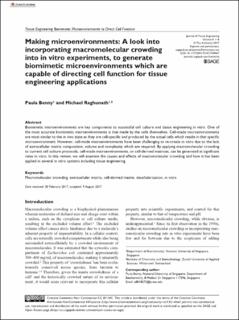Please use this identifier to cite or link to this item:
https://doi.org/10.21256/zhaw-4841| Publication type: | Article in scientific journal |
| Type of review: | Not specified |
| Title: | Making microenvironments : a look into incorporating macromolecular crowding into in vitro experiments, to generate biomimetic microenvironments which are capable of directing cell function for tissue engineering applications |
| Authors: | Benny, Paula Raghunath, Michael |
| DOI: | 10.21256/zhaw-4841 10.1177/2041731417730467 |
| Published in: | Journal of Tissue Engineering |
| Issue Date: | 2017 |
| Publisher / Ed. Institution: | Sage |
| ISSN: | 2041-7314 |
| Language: | English |
| Subject (DDC): | 571: Physiology and related subjects |
| Abstract: | Biomimetic microenvironments are key components to successful cell culture and tissue engineering in vitro. One of the most accurate biomimetic microenvironments is that made by the cells themselves. Cell-made microenvironments are most similar to the in vivo state as they are cell-specific and produced by the actual cells which reside in that specific microenvironment. However, cell-made microenvironments have been challenging to re-create in vitro due to the lack of extracellular matrix composition, volume and complexity which are required. By applying macromolecular crowding to current cell culture protocols, cell-made microenvironments, or cell-derived matrices, can be generated at significant rates in vitro. In this review, we will examine the causes and effects of macromolecular crowding and how it has been applied in several in vitro systems including tissue engineering. |
| URI: | https://digitalcollection.zhaw.ch/handle/11475/12127 |
| Fulltext version: | Published version |
| License (according to publishing contract): | CC BY-NC 4.0: Attribution - Non commercial 4.0 International |
| Departement: | Life Sciences and Facility Management |
| Organisational Unit: | Institute of Chemistry and Biotechnology (ICBT) |
| Appears in collections: | Publikationen Life Sciences und Facility Management |
Files in This Item:
| File | Description | Size | Format | |
|---|---|---|---|---|
| 2017_Benny_Making_microenvironments.pdf | 116.45 kB | Adobe PDF |  View/Open |
Show full item record
Benny, P., & Raghunath, M. (2017). Making microenvironments : a look into incorporating macromolecular crowding into in vitro experiments, to generate biomimetic microenvironments which are capable of directing cell function for tissue engineering applications. Journal of Tissue Engineering. https://doi.org/10.21256/zhaw-4841
Benny, P. and Raghunath, M. (2017) ‘Making microenvironments : a look into incorporating macromolecular crowding into in vitro experiments, to generate biomimetic microenvironments which are capable of directing cell function for tissue engineering applications’, Journal of Tissue Engineering [Preprint]. Available at: https://doi.org/10.21256/zhaw-4841.
P. Benny and M. Raghunath, “Making microenvironments : a look into incorporating macromolecular crowding into in vitro experiments, to generate biomimetic microenvironments which are capable of directing cell function for tissue engineering applications,” Journal of Tissue Engineering, 2017, doi: 10.21256/zhaw-4841.
BENNY, Paula und Michael RAGHUNATH, 2017. Making microenvironments : a look into incorporating macromolecular crowding into in vitro experiments, to generate biomimetic microenvironments which are capable of directing cell function for tissue engineering applications. Journal of Tissue Engineering. 2017. DOI 10.21256/zhaw-4841
Benny, Paula, and Michael Raghunath. 2017. “Making Microenvironments : A Look into Incorporating Macromolecular Crowding into in Vitro Experiments, to Generate Biomimetic Microenvironments Which Are Capable of Directing Cell Function for Tissue Engineering Applications.” Journal of Tissue Engineering. https://doi.org/10.21256/zhaw-4841.
Benny, Paula, and Michael Raghunath. “Making Microenvironments : A Look into Incorporating Macromolecular Crowding into in Vitro Experiments, to Generate Biomimetic Microenvironments Which Are Capable of Directing Cell Function for Tissue Engineering Applications.” Journal of Tissue Engineering, 2017, https://doi.org/10.21256/zhaw-4841.
Items in DSpace are protected by copyright, with all rights reserved, unless otherwise indicated.